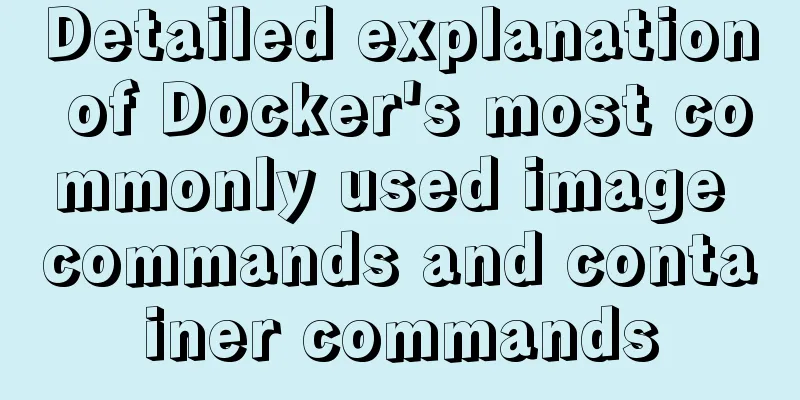Detailed explanation of Docker's most commonly used image commands and container commands

|
This article lists the most commonly used image commands and container commands in the use of Docker, and teaches you how to operate container data volumes and back up container data. After you have mastered these commands, you can practice some simple application deployment and learn more about Docker image building, backup, recovery, migration, image repository, network, cluster, and more. Mirror related commands Official documentation: https://docs.docker.com/reference/ View Mirror [root@localhost ~]# docker images REPOSITORY TAG IMAGE ID CREATED SIZE hello-world latest bf756fb1ae65 7 months ago 13.3kB
These images are stored in the Search Mirror If you need to find the required image from the network, you can search it with the following command. docker search image name
Pull the image Pulling an image means downloading the image from the central repository to the local computer. docker pull image name If I want to pull the centos image to the local computer, if I do not declare the tag image label information, the latest version will be pulled by default. You can also search for the image through: https://hub.docker.com/ to view the supported tag information.
By viewing the tag information, if we want to download the centos7 image. docker pull centos:7 Deleting an image Delete an image by its ID. # Delete a single image docker rmi image ID # Delete multiple images docker rmi image ID image ID image ID docker rmi `docker images -q` Note: If a container is created from an image, the image cannot be deleted. Solution: Delete the container in the image first, and then delete the image. Container related commands View Container View the running containers. [root@localhost ~]# docker ps CONTAINER ID IMAGE COMMAND CREATED STATUS PORTS NAMES
View stopped containers. docker ps -f status=exited View all containers (both running and stopped). docker ps -a View the last running container. docker ps -l Creating and starting a container docker run [OPTIONS] IMAGE [COMMAND] [ARG...]
Create and enter the container The following command line means to create a container BB through the image AA, run the container and enter the container's docker run -it --name container name image name: tag /bin/bash Note: A Docker container must have a foreground process to run. If there is no foreground process executing, the container is considered to be in an idle state and will automatically exit. Exit the current container exit Creating containers in a guarded manner docker run -di --name container name image name: tag Login guard container mode docker exec -it container name | container ID /bin/bash Stopping and starting containers # Stop the container docker stop container name | container ID # Start the container docker start container name | container ID File Copy If we need to copy files into the container, we can use the cp command. docker cp The file or directory to be copied Container name: container directory It is also possible to copy files out of the container. docker cp container name: the file or directory to be copied in the container directory Directory mount (container data volume operation) When creating a container, we can map the host directory to the directory in the container, so that we can affect the container by modifying the files in a directory of the host. This operation is bidirectionally bound, which means that the operation in the container will also affect the host, realizing the backup function. However, when the container is deleted, the contents of the host machine will not be deleted because the underlying layer is implemented through copying. If multiple containers mount the same directory and one of the containers is deleted, the contents of other containers will not be affected. Similarly, the underlying layer is implemented by copying. However, when the container is deleted, the contents of the host are not deleted. If multiple containers mount the same directory and one of the containers is deleted, the contents of the other containers will not be affected. The data volume between the container and the host is a reference relationship. The data volume is mounted from the outside to the container, so it can exist independently from the container life cycle. Precisely because the life cycle of the data volume is not the same as the life cycle of the container, the data volume will not be affected after the container exits or is deleted. The life cycle of the data volume will continue until no container uses it. When creating a container, add the docker run -di -v /mydata/docker_centos/data:/usr/local/data --name centos7-01 centos:7 # Multiple directories mount docker run -di -v /host directory:/container directory -v /host directory 2:/container directory 2 image name The directory mounting operation may prompt that insufficient permissions are required. This is because the security module SELinux in CentOS7 has disabled permissions. When running docker, add permissions to the container by using Anonymous Mount Anonymous mounting only requires writing to the container directory, and the corresponding directory outside the container will be generated in # Anonymous mount docker run -di -v /usr/local/data --name centos7-02 centos:7 # View volume data volume information docker volume ls
Named mount Named mounting is to give the data volume a name, and the corresponding directory outside the container will be generated in # Anonymous mount docker run -di -v docker_centos_data:/usr/local/data --name centos7-03 centos:7 # View volume data volume information docker volume ls
Specify directory to mount The method explained to you at the beginning is to mount the specified directory. This method of mounting will not generate content in the docker run -di -v /mydata/docker_centos/data:/usr/local/data --name centos7-01 centos:7 # Multiple directories mount docker run -di -v /host directory:/container directory -v /host directory 2:/container directory 2 image name View directory mount relationships You can view the directory address of the host machine corresponding to the data volume by [root@localhost ~]# docker volume inspect docker_centos_data
[
{
"CreatedAt": "2020-08-13T20:19:51+08:00",
"Driver": "local",
"Labels": null,
"Mountpoint": "/var/lib/docker/volumes/docker_centos_data/_data",
"Name": "docker_centos_data",
"Options": null,
"Scope": "local"
}
] You can view detailed data mount information by
Read-only/Read-write # Read-only. The data management of the container can only be achieved by modifying the host content. docker run -it -v /host directory:/container directory:ro image name# Read-write, default. The host and the container can operate data in both directions. docker run -it -v /host directory:/container directory:rw image name volumes-from (inheritance) # Container centos7-01 specifies the directory to mount docker run -di -v /mydata/docker_centos/data:/usr/local/data --name centos7-01 centos:7 # Containers centos7-04 and centos7-05 are equivalent to inheriting the mount directory of the centos7-01 container docker run -di --volumes-from centos7-01 --name centos7-04 centos:7 docker run -di --volumes-from centos7-01 --name centos7-05 centos:7 View the container IP address We can view the container's meta information with the following command. docker inspect container name | container ID You can also directly execute the following command to output the IP address directly. docker inspect --format='{{.NetworkSettings.IPAddress}}' container name | container IDDeleting a container # Delete the specified container docker rm container name | container ID # Delete multiple containers docker rm container name | container ID container name | container ID I have previously introduced to you the detailed usage of the Docker run command. Friends who are interested can refer to it! This concludes this article about the most commonly used Docker image commands and container commands. For more relevant Docker image commands and container commands, please search for previous articles on 123WORDPRESS.COM or continue to browse the following related articles. I hope you will support 123WORDPRESS.COM in the future! You may also be interested in:
|
<<: js to achieve a simple lottery function
>>: How to solve the high concurrency problem in MySQL database
Recommend
Usage and difference of Js module packaging exports require import
Table of contents 1. Commonjs exports and require...
js memory leak scenarios, how to monitor and analyze them in detail
Table of contents Preface What situations can cau...
LinkedIn revamps to simplify website browsing
Business social networking site LinkedIn recently...
In-depth explanation of MySQL common index and unique index
Scenario 1. Maintain a citizen system with a fiel...
Detailed explanation of Linux Namespace User
User namespace is a new namespace added in Linux ...
Zabbix monitors Linux hosts based on snmp
Preface: The Linux host is relatively easy to han...
Using group by in MySQL always results in error 1055 (recommended)
Because using group by in MySQL always results in...
Detailed explanation of the principles and usage of MySQL data types and field attributes
This article describes the MySQL data types and f...
MySQL learning record: bloody incident caused by KEY partition
Demand background Part of the data in the busines...
Solution to Mysql binlog log file being too large
Table of contents 1. Related binlog configuration...
JavaScript String Object Methods
Table of contents Methods of String Object Method...
Vite introduces the implementation of virtual files
Table of contents background Importing virtual fi...
Building command line applications with JavaScript
Table of contents 1. Install node 2. Install Comm...
Several methods to solve the problem of MySQL fuzzy query index failure
When we use the like % wildcard, we often encount...
The difference between br and br/ in HTML
answer from stackflow: Simply <br> is suffic...














